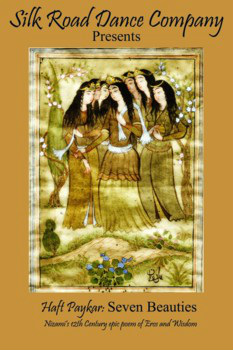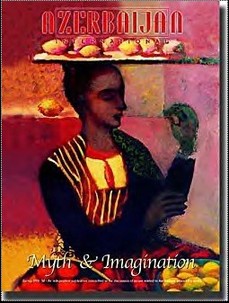Silk Road Dance Company ®
|
Video clip of 2011 Production of Haft Paykar: Seven Beauties
|
Haft Paykar: Seven Beauties
World Premiere
APRIL 2,2005 Publick Playhouse Cheverly, Maryland : Metro Washington DC Area DC Choreographer Brings Persian Epic to the Stage The 2005 World Dance Showcase, sponsored by the Maryland-National Capital Park and Planning Commission (MNCPPC), featured a major new folkloric ballet, 'Haft Paykar: Seven Beauties,' by award winning choreographer Laurel Victoria Gray and her Silk Road Dance Company. Haft Paykar celebrates ethnic diversity, extols the beauty of other cultures, and praises the wisdom of women. Written by the Persian poet Nizami in 1197, it is an epic romance. In the tale, the young warrior Bahram Gur enters a mysterious, locked room to discover the portraits of seven beautiful princesses, each from a different land. After he wins a kingdom and achieves great wealth and power, he remembers the maidens and sets out on a quest to bring each to his kingdom, commissioning the architect Shideh to build seven domed structures – one for each bride. No simple fairy tale, Haft Paykar is an erotic allegory about a quest for human perfection steeped in numerology, geometry, astrology and color symbolism. Not only does each princess of Haft Paykar come from a different country, or “clime,” but each is associated with a different color, planet and virtue. Each of the seven maidens tells a tale to her bridegroom that imparts a specific moral lesson. From these wise women the hero learns patience, truth, faith, passion, serenity, fairness and devotion to God. Since Bahram Gur is destined to become Ruler of the World, he must learn these lessons in order to govern wisely. His spiritual journey is a reminder that only through self-knowledge and self-mastery can humans find perfection. Gray views this ambitious project as an opportunity to bring to American audiences the ecstatic, esoteric side of Islamic culture. “As one familiar with the culture and history of both East and West, I feel it is imperative to use art to build a bridge of understanding between Americans and the Islamic world. Instead of falling prey to the false notion of a ‘clash of civilizations,’ we need to remember that East and West have interacted for millennia, often crossing cultures with positive results.” Gray feels the framing story of Haft Paykar -- the education of a ruler who has achieved great wealth and power but is in need of wisdom from other cultures -- gives the medieval epic “an eerie immediacy.” To view Haft Paykar as the stereotypical “sultan and the slave girls” story of Hollywood movies, Gray contends, would be “primitive and superficial.” Bahram Gur sends to the far reaches of the known world to bring the wisdom of other lands to his court. “When he embraces a princess, he embraces her culture, her traditions.” Gray believes that “the exquisite beauty of the dance, poetry and music of the Islamic world reveals a different face from the austere fundamentalism known to most Americans. Nizami uses movement, color, words, music, scent and taste to express deep mystical concepts. Here, in the hidden gardens of allegory, beauty that appeals to the senses becomes a way of finding oneness with God.” |
Silk Road Dance Company ® is a Registered Trademark of the Silk Road Dance Company,
A Maryland nonprofit corporation and a 501(c)3 exempt tax non-profit organization.
Silk Road Dance Company P.O. Box 11346 Takoma Park, MD 20913 • 301-585-1105 • [email protected]
The contents of this website, including all text and images, are protected and may not be used without the express written permission of Silk Road Dance Company®.
Copyright 2013, Silk Road Dance Company ®. All rights reserved.
A Maryland nonprofit corporation and a 501(c)3 exempt tax non-profit organization.
Silk Road Dance Company P.O. Box 11346 Takoma Park, MD 20913 • 301-585-1105 • [email protected]
The contents of this website, including all text and images, are protected and may not be used without the express written permission of Silk Road Dance Company®.
Copyright 2013, Silk Road Dance Company ®. All rights reserved.

